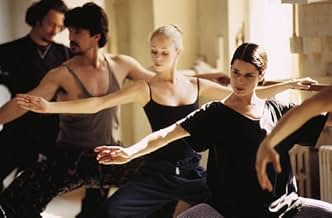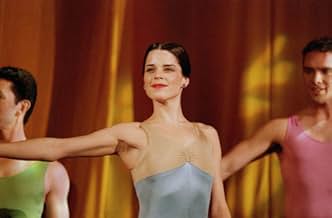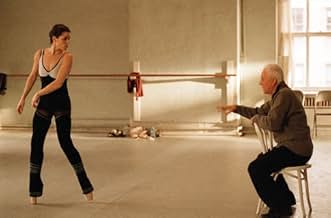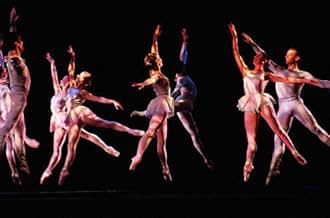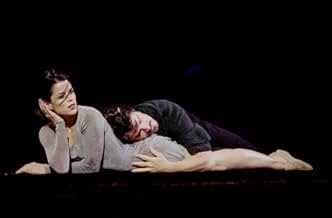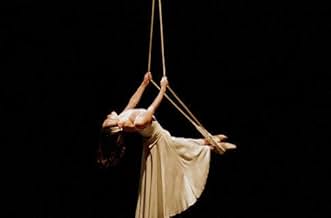CALIFICACIÓN DE IMDb
6.2/10
6.9 k
TU CALIFICACIÓN
Ry (Neve Campbell) es una excelente pero conflictiva bailarina que tiene la oportunidad de convertirse en la primera bailarina de una prestigiosa compañía de ballet dirigida por uno de los m... Leer todoRy (Neve Campbell) es una excelente pero conflictiva bailarina que tiene la oportunidad de convertirse en la primera bailarina de una prestigiosa compañía de ballet dirigida por uno de los mejores coreógrafos de América.Ry (Neve Campbell) es una excelente pero conflictiva bailarina que tiene la oportunidad de convertirse en la primera bailarina de una prestigiosa compañía de ballet dirigida por uno de los mejores coreógrafos de América.
- Premios
- 2 nominaciones en total
Barbara E. Robertson
- Harriet
- (as Barbara Robertson)
Davis C. Robertson
- Alec - Joffrey Dancer
- (as Davis Robertson)
Argumento
¿Sabías que…?
- TriviaNeve Campbell lost thousands of dollars of her own money to ensure that her fellow cast members received their wages.
- ErroresAt about 1:10 while counting during a rehearsal, Harriet skips the 6th count of 8.
- Citas
Alberto Antonelli: Ry, honey, let's scramble some ideas, instead of some asshole who contradicts me.
- Créditos curiososAfter the closing credits begin rolling, the dancers continue to take their final bows, and the audience continues to applaud.
Opinión destacada
The Company is far below the level of Robert Altman's best efforts. In contrast with Gosford Park's endlessly fascinating chatter weaving an intricate web of intrigues and secrets, there's much stretching and dancing, but very little delving into the backgrounds or relationships of the principals. There's hardly what you could call a plot. There are only a few strong characters. All you really get to hold things together somehow or provide some sense of continuity is a series of things that go wrong:
(1) Among the many dance `numbers,' the one that stands out is the first, an outdoor performance featuring the Hollywood actress Neve Campbell (Scream 1,2, and 3, Wild Things), a trained dancer and the force behind the making of the whole film. A thunderstorm comes to buffet the audience and the dancers. The dancers bravely go on and the dance -- so we're told, anyway -- is a triumph. The entire sequence is dominated by a sense of impending disaster. A slippery stage could have meant serious injury. One also wonders about damage to valuable string instruments being played in the open to accompany the dance. All this is extremely distracting and excruciating to watch. Altman does succeed though in giving us a sense of what performances are like from the company's point of view -- struggles with physical problems; successful efforts (at best) to avert disaster.
(2) An injury forces a new lead dancer to give up a role. This happens twice. We realize that dancers constantly face injury, or, as often, are dangerously in denial that they have one.
(3) Another sort of injury prevents a dancer from performing the whole of a `number.' This happens to Neve Campbell at the end of the movie. It's just an arm injury, so not career-threatening, but enough to require a quick replacement by a stand-in.
(4) A young man is replaced, but only for the latter part of a dance he's in -- because his energy seems to flag at that point in the performance. This nonetheless results in a terribly bruised ego for the young man and his union rep promises to lodge a formal protest. We get a sense of the constant threats to the ego in such an arbitrarily run system, along with the surprising news that union redress may be available in such cases.
(5) One of the guys in the company takes a new girlfriend. This time again it's Neve Campbell who's the `injured' one, and at a post-performance celebration she delivers an `I was the last to know' speech to the bad boy. I saw nods of agreement from dancerly-looking audience members during this moment.
(6) The aging female lead dancer - she's 43 - repeatedly protests about too-challenging new dances and refuses to make changes in the choreography of old ones. This potentially interesting, possibly tragic, theme of aging in what is really one of the world's most demanding sports is, however, only briefly touched on.
(7) An argument occurs between the director and one dancer, who hates choreography of a dance he's in, in which men wearing skirts `give birth' -- and the director instantly reverses what he said about how to perform this moment the day before. The director is adamant, the dancer has lost his cool, and the conversation breaks down. He frequently ends unsatisfactory conversations by dismissing his interlocutor. The director's rule is autocratic and rarely challenged. However the company does get mild revenge toward the end in a mock restaging of the season's events at a party.
All this adds up to something so generic and uninteresting as emotional truth or human experience that you are deeply grateful when at least the main dancer character, Neve Campbell, gets hooked up with a cook boyfriend, the intriguing James Franco. You're thankful for one young male movie star in the piece, because the real dancer `actors' - as usual - have very little presence or ability as actors. All James Franco gets to do is smile, kiss the girl, take off his shirt, and break some eggs. He does these things with lots of charm and charisma, but these are just crumbs tossed to us. The point however seems to be that dancers don't have time for much more than quick sex; it's like smoking a cigarette, something squeezed in.
Altman's casts are usually heavy with talent. This time there are only three leads, Campbell, McDowell, and Franco. Ironically only the least used, Franco, has any real appeal.
Ms. Campbell is little more than bustling and workmanlike. She has a few minutes with her pushy stage mother that provide some sense of relationships outside the company, but it's not enough.
You will have a lot of trouble with this movie if you don't like Malcolm McDowell. As the `Italian' company director Alberto Altonelli, he is brusque, bossy, obtrusive -- really just a flaming a**hole with a lot of power to abuse. Is this how dance companies work? Where's the genius? Why does young Franco have more charisma and sex appeal? And what's this about a ceremony in which the blatantly English McDowell gets an award for `honoring the Italian-American community'? Okay; let's pretend that he's Italian. But do we have to pretend he has no English accent? If that weren't bad enough, his little speech about not discouraging their sons from becoming ballet dancers is jarring and crude, like all his speeches: it's the height of ingratitude, and you wonder how anyone so undiplomatic could get money for his company. Is it just possible that McDowell is a jarring and crude actor? His performance is wooden and unsubtle. All he has to qualify for this role is forcefulness. Granted, he has that. But his scenes are nothing but irritations.
This is, at best, a generic treatment of an American ballet company. But it fails even on that level. How come none of the male dancers, not one, is shown to be gay? Isn't that a bit unrealistic about the culture of dance? Why the pretense that they're all straight, vying to have sex with the female dancers in the company?
Neve's partner after their triumph in the rain has a private improv session unwinding to a Bach solo cello suite. It's rather fun - and would have worked better if it had been allowed to run by itself and not been constantly intercut with the scene of Neve in her apartment - a huge Hollywood-style creation right by the `El' with a glam bath. The improvised Bach session makes you realize that Flash Dance was better than this. There was another movie about a dance company, featuring real dancers again, that was better than this. It had a bit more plot, and perhaps better dances; the people seemed a tad more real as people - and yet it wasn't a great movie. Altman's film has spectacular dance sequences at the beginning and the end but they're just staging, not great dance, and they're window dressing to cover up the emptiness of the whole production.
If you love dance and/or Altman you'll doubtless have to see this picture, but you won't be watching a particularly memorable ballet movie or getting Altman even at his average level.
(1) Among the many dance `numbers,' the one that stands out is the first, an outdoor performance featuring the Hollywood actress Neve Campbell (Scream 1,2, and 3, Wild Things), a trained dancer and the force behind the making of the whole film. A thunderstorm comes to buffet the audience and the dancers. The dancers bravely go on and the dance -- so we're told, anyway -- is a triumph. The entire sequence is dominated by a sense of impending disaster. A slippery stage could have meant serious injury. One also wonders about damage to valuable string instruments being played in the open to accompany the dance. All this is extremely distracting and excruciating to watch. Altman does succeed though in giving us a sense of what performances are like from the company's point of view -- struggles with physical problems; successful efforts (at best) to avert disaster.
(2) An injury forces a new lead dancer to give up a role. This happens twice. We realize that dancers constantly face injury, or, as often, are dangerously in denial that they have one.
(3) Another sort of injury prevents a dancer from performing the whole of a `number.' This happens to Neve Campbell at the end of the movie. It's just an arm injury, so not career-threatening, but enough to require a quick replacement by a stand-in.
(4) A young man is replaced, but only for the latter part of a dance he's in -- because his energy seems to flag at that point in the performance. This nonetheless results in a terribly bruised ego for the young man and his union rep promises to lodge a formal protest. We get a sense of the constant threats to the ego in such an arbitrarily run system, along with the surprising news that union redress may be available in such cases.
(5) One of the guys in the company takes a new girlfriend. This time again it's Neve Campbell who's the `injured' one, and at a post-performance celebration she delivers an `I was the last to know' speech to the bad boy. I saw nods of agreement from dancerly-looking audience members during this moment.
(6) The aging female lead dancer - she's 43 - repeatedly protests about too-challenging new dances and refuses to make changes in the choreography of old ones. This potentially interesting, possibly tragic, theme of aging in what is really one of the world's most demanding sports is, however, only briefly touched on.
(7) An argument occurs between the director and one dancer, who hates choreography of a dance he's in, in which men wearing skirts `give birth' -- and the director instantly reverses what he said about how to perform this moment the day before. The director is adamant, the dancer has lost his cool, and the conversation breaks down. He frequently ends unsatisfactory conversations by dismissing his interlocutor. The director's rule is autocratic and rarely challenged. However the company does get mild revenge toward the end in a mock restaging of the season's events at a party.
All this adds up to something so generic and uninteresting as emotional truth or human experience that you are deeply grateful when at least the main dancer character, Neve Campbell, gets hooked up with a cook boyfriend, the intriguing James Franco. You're thankful for one young male movie star in the piece, because the real dancer `actors' - as usual - have very little presence or ability as actors. All James Franco gets to do is smile, kiss the girl, take off his shirt, and break some eggs. He does these things with lots of charm and charisma, but these are just crumbs tossed to us. The point however seems to be that dancers don't have time for much more than quick sex; it's like smoking a cigarette, something squeezed in.
Altman's casts are usually heavy with talent. This time there are only three leads, Campbell, McDowell, and Franco. Ironically only the least used, Franco, has any real appeal.
Ms. Campbell is little more than bustling and workmanlike. She has a few minutes with her pushy stage mother that provide some sense of relationships outside the company, but it's not enough.
You will have a lot of trouble with this movie if you don't like Malcolm McDowell. As the `Italian' company director Alberto Altonelli, he is brusque, bossy, obtrusive -- really just a flaming a**hole with a lot of power to abuse. Is this how dance companies work? Where's the genius? Why does young Franco have more charisma and sex appeal? And what's this about a ceremony in which the blatantly English McDowell gets an award for `honoring the Italian-American community'? Okay; let's pretend that he's Italian. But do we have to pretend he has no English accent? If that weren't bad enough, his little speech about not discouraging their sons from becoming ballet dancers is jarring and crude, like all his speeches: it's the height of ingratitude, and you wonder how anyone so undiplomatic could get money for his company. Is it just possible that McDowell is a jarring and crude actor? His performance is wooden and unsubtle. All he has to qualify for this role is forcefulness. Granted, he has that. But his scenes are nothing but irritations.
This is, at best, a generic treatment of an American ballet company. But it fails even on that level. How come none of the male dancers, not one, is shown to be gay? Isn't that a bit unrealistic about the culture of dance? Why the pretense that they're all straight, vying to have sex with the female dancers in the company?
Neve's partner after their triumph in the rain has a private improv session unwinding to a Bach solo cello suite. It's rather fun - and would have worked better if it had been allowed to run by itself and not been constantly intercut with the scene of Neve in her apartment - a huge Hollywood-style creation right by the `El' with a glam bath. The improvised Bach session makes you realize that Flash Dance was better than this. There was another movie about a dance company, featuring real dancers again, that was better than this. It had a bit more plot, and perhaps better dances; the people seemed a tad more real as people - and yet it wasn't a great movie. Altman's film has spectacular dance sequences at the beginning and the end but they're just staging, not great dance, and they're window dressing to cover up the emptiness of the whole production.
If you love dance and/or Altman you'll doubtless have to see this picture, but you won't be watching a particularly memorable ballet movie or getting Altman even at his average level.
- Chris Knipp
- 3 feb 2004
- Enlace permanente
Selecciones populares
Inicia sesión para calificar y agrega a la lista de videos para obtener recomendaciones personalizadas
- How long is The Company?Con tecnología de Alexa
Detalles
Taquilla
- Presupuesto
- USD 15,000,000 (estimado)
- Total en EE. UU. y Canadá
- USD 2,283,914
- Fin de semana de estreno en EE. UU. y Canadá
- USD 93,776
- 28 dic 2003
- Total a nivel mundial
- USD 6,415,017
- Tiempo de ejecución1 hora 52 minutos
- Color
- Mezcla de sonido
- Relación de aspecto
- 2.35 : 1
Contribuir a esta página
Sugiere una edición o agrega el contenido que falta

Principales brechas de datos
By what name was El acto (2003) officially released in India in English?
Responda






